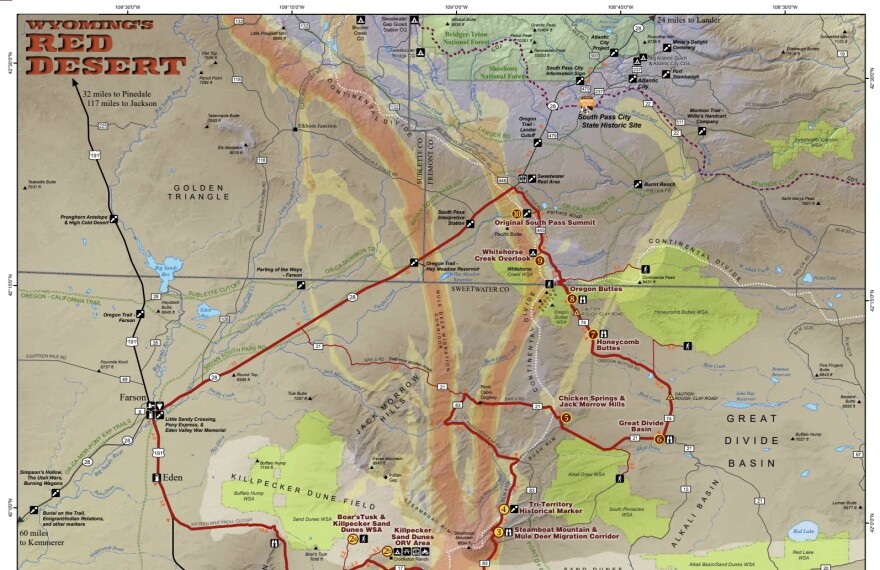Retired wildlife biologist Tom Christianson braced against the southwest Wyoming wind. His broad brimmed hat was no match.
“Thank you for catching my hat,” he chuckled on a late summer day. “This is a ball cap day, not a broad brimmed hat day.”
The Wind River Range towers behind Christianson. Pronghorn nibble grass speckled between endless sagebrush.

This section of desert is framed between the mountains and two highways. It’s dubbed the Golden Triangle, coined many years ago by Christianson and another biologist while “simply riding around out here in our truck one day, talking about the values of this country to wildlife.”
There are three world records in this critical wildlife nexus: highest density of sage grouse, longest mule deer migration and the largest pronghorn herd. All three populations are struggling, along with their habitat – sagebrush.
“Either through development, urbanization, energy development, wildfire is a huge one,” Christianson said.
This federal land is still largely untouched, despite it being just a highway and a few ranches away from one of the nation’s top producing natural gas fields.

Historically, the Golden Triangle has been mostly closed to development to protect these species of concern. In fact, Wyoming is poised to bump up protections, specifically for the world’s largest pronghorn herd, the Sublette Pronghorn. But federal directives for Unleashing American Energy could put a hitch in those plans.
A federal report released this year shows oil and gas is flowing under some of the untouched parts of southwest Wyoming, like the Golden Triangle. The Trump administration thinks newer technology could access those hard to reach deposits, and they want to explore it.
“So that does not bode well for the future,” Christianson said, as he points out the world’s largest sage grouse lek just over a sagebrush noll.
Christianson said this conflict is a tale as old as time for the state: trying to balance multiple use interests on public land. It was on full display at a recent Wyoming Game and Fish Commission meeting in Lander.
“What is our role in balancing wildlife habitat with livestock, oil, gas development, which is our lifeblood, tourism?” said Commissioner John Masterson.

He and his colleagues were deliberating whether to add safeguards for the Sublette Pronghorn herd, which biologists say is threatened by habitat fragmentation, caused in part by energy development.
Masterson repeatedly asked the public in attendance, “If you were sitting up here, how would you weigh these things?”
The room was peppered with cowboy hats, hiking boots and suits. Everyone agreed: They support wildlife, including Petroleum Association of Wyoming’s President Pete Obermueller.
“It's like asking if you support mom and apple pie – of course we all do. There is no question about that,” Obermueller said.
He said nearby natural gas operations already limit activities during some peak migrations and mating seasons. He worried adding more wildlife protections could be used as fuel to shut down industry.
“It's not hypothetical. It's real, and in my position, I have to fight it every day,” Obermueller said.

Commissioners agreed, but ultimately followed the majority of public comments asking for protections and gave their stamp of approval.
Now it’s in the Governor’s hands. If approved, it would limit development in migration bottlenecks.
But Angie Bruce, director of the Wyoming Game and Fish Department, said, “If there's federal land with a federal lease or permit, it definitely would override a state jurisdiction.”
So even if the state adds protections for the Sublette Pronghorn herd’s migration route, the Trump administration’s upcoming revisions to a federal land use plan for some of the same area would supersede it.
“We really want our federal partners to sort of pass the buck to us, rather than doing it separate from us,” Bruce said.

However, it’s not clear what the feds are doing, since the government is shut down.
Back in the Golden Triangle, Tom Christianson clutched his hat. He looked over the desolate and harsh desert landscape.
He said it’s wide open, not because of our “intensive and intentional design to keep it wild and free and open.”
But rather because “the soil sucks and the precipitation sucks.”
Christianson called it the edge of existence. But with federal changes likely coming down the pipeline, it might not be forever.








